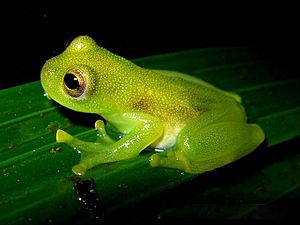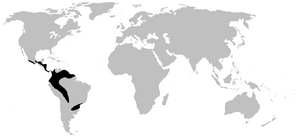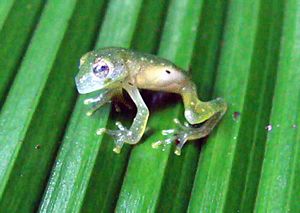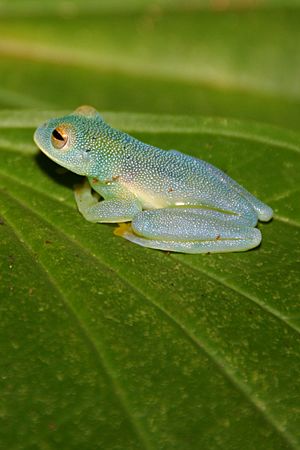Glass frog facts for kids
Quick facts for kids Glass frog |
|
|---|---|
 |
|
| Hyalinobatrachium ruedai | |
| Scientific classification | |
| Kingdom: | |
| Phylum: | |
| Class: | |
| Order: | |
| Suborder: | |
| Family: |
Centrolenidae
Taylor, 1951
|
| Subfamilies | |
|
Hyalinobatrachinae |
|
 |
|
| Distribution of Centrolenidae (in black) | |
The glass frog is a special kind of frog. It gets its name because some of these frogs have skin on their bellies that you can see right through! This means you can actually see their insides, like their heart and liver. Most glass frogs are a bright lime green color. They belong to a group of frogs called the Centrolenidae family.
Contents
What do they look like?
Glass frogs are usually quite small. They can be anywhere from about 2 to 7.5 centimeters (0.75 to 3 inches) long. Their bodies are mostly green.
The most amazing thing about them is their see-through skin on their underside.
Glass frogs look a bit like other green frogs, especially some tree frogs. But you can tell them apart by their eyes. Glass frogs have eyes that face forward, while many other tree frogs have eyes that face more to the side.
Where Do Glass Frogs Live?
These fascinating frogs live in many parts of Central and South America. You can find them from southern Mexico all the way down to Panama. They also live in the Andes mountains, stretching from Venezuela and the island of Tobago to Bolivia. Some species also live near the Amazon River and Orinoco River basins. You can also find them in southeastern Brazil and northern Argentina.
Habitat
Glass frogs mostly live in trees. They are often found near rivers and streams, especially when it's time for them to lay eggs. Many species live in the cool, misty cloud forests of Central and South America. Some also live in the warm, wet rainforests.
Reproduction and Life Cycle
Glass frogs usually lay their eggs on the leaves of trees or bushes. These leaves hang right over the running water of mountain streams, creeks, or small rivers. One special type of glass frog even lays its eggs on rocks near waterfalls!
Once the eggs hatch, the tiny tadpoles simply drop into the water below. These tadpoles are long and have strong tails. They also have low fins, which are perfect for swimming in fast-moving water. When they are not breeding, some glass frogs spend their time high up in the forest canopy.
Adaptations
The glass frog's incredible transparency is an evolutionary adaptation that helps them blend in with their surroundings. The frog's legs are more transparent, and the body has light-diffusing pigments that help blur the outline of its silhouette against the leaf. When resting, it tucks its legs close, making it incredibly hard for a visual predator (like a bird) to distinguish it from the leaf. This helps them stay safe from predators.
Predators
- Snakes: Arboreal snakes, like cat-eyed snakes and vine snakes, are their primary predator. They use heat, smell, and movement detection, not just sight.
- Birds: Especially nocturnal birds like owls, potoos, and nightjars, which hunt by sound and movement in the dark.
- Mammals: Bats, monkeys, and opossums may prey on them.
- Spiders & Large Insects: Giant orb-weaver spiders, praying mantises, and even large centipedes can catch adult frogs.
Threats
The greatest threat to glass frogs is habitat loss (deforestation, climate change, and pollution). Their specialized rainforest stream ecosystems are fragile, and without them, no amount of transparency can save them.
Types of Glass Frogs
The Centrolenidae family includes many different kinds of glass frogs. Scientists have grouped them into different subfamilies and genera (which are like smaller groups). Here are some of the main groups:
- Subfamily Centroleninae
- Genus Centrolene
- Genus Cochranella
- Genus Nymphargus
- Subfamily Hyalinobatrachinae
- Genus Hyalinobatrachium - These are sometimes called the "True" Glass Frogs.
- Subfamily Allophryninae
See also
 In Spanish: Ranas de cristal para niños
In Spanish: Ranas de cristal para niños



